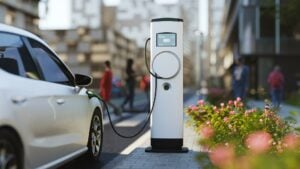DC Fast Charging vs. Level 2: Choosing the Right EV Charging Solution
Understanding DC Fast Charging vs. Level 2 Charging
 Electric vehicle (EV) adoption is growing, and businesses must decide which charging infrastructure best suits their needs. The two main options are Level 2 charging and DC fast charging. Each has distinct advantages depending on speed, cost, and space requirements. Understanding the key differences helps commercial property owners, fleet managers, and municipalities make informed decisions.
Electric vehicle (EV) adoption is growing, and businesses must decide which charging infrastructure best suits their needs. The two main options are Level 2 charging and DC fast charging. Each has distinct advantages depending on speed, cost, and space requirements. Understanding the key differences helps commercial property owners, fleet managers, and municipalities make informed decisions.
What is Level 2 Charging?
Level 2 charging operates on a 240-volt power supply, making it suitable for commercial properties, workplaces, and public parking areas. Depending on the vehicle and charger specifications, it typically delivers 10 to 60 miles of range per hour. This type of charger is ideal for locations where EVs remain parked for several hours, such as office buildings, hotels, and residential complexes.
What is DC Fast Charging?
DC fast charging, or Level 3 charging, uses direct current (DC) to charge EV batteries much faster. Unlike Level 2 chargers, which rely on alternating current (AC) and require the vehicle’s onboard charger to convert power, DC fast chargers supply power directly to the battery. This allows for significantly faster charging—adding 100 to 250 miles of range in as little as 30 minutes. DC fast chargers are commonly found along highways, fleet depots, and high-traffic commercial areas.
Key Differences Between Level 2 and DC Fast Charging
- Charging Speed – Level 2 chargers require multiple hours to fully charge an EV, whereas DC fast chargers can complete the process in less than an hour.
- Installation Cost – Level 2 charging stations have lower installation costs, whereas DC fast chargers require more power and infrastructure investment.
- Use Case—Level 2 is ideal for long-duration parking, while DC fast charging is designed for quick charging in busy locations.
Businesses must evaluate these factors to determine the right EV charging solution based on their budget, property layout, and customer needs.
Charging Speed: How Fast Do You Need to Charge?
Charging speed is one of the most critical factors when comparing DC fast charging vs. Level 2 charging. The time required to charge an EV impacts customer convenience, fleet efficiency, and overall operational effectiveness.
Average Charging Time for Level 2
Level 2 chargers provide a steady but moderate charging rate. On average, a Level 2 station can charge an EV battery at 10 to 60 miles of range per hour. The total charging time varies based on battery size and vehicle compatibility. Most EVs take 4 to 8 hours to reach a full charge using a Level 2 charger.
This option is ideal for businesses where EVs remain parked for extended periods, such as:
- Workplaces where employees charge vehicles throughout the workday.
- Hotels and resorts where guests leave cars overnight.
- Apartments and condominiums where residents charge vehicles at home.
Average Charging Time for DC Fast Charging
DC fast chargers deliver significantly more power, reducing charging times. Depending on the charger’s power output and vehicle compatibility, DC fast charging can provide:
- 100 to 250 miles of range in 15 to 45 minutes.
- 80% battery charge in approximately 30 minutes for most EVs.
DC fast charging is best suited for locations requiring quick turnaround times, such as:
- Highway rest stops where drivers need a rapid charge before continuing their trip.
- Fleet operations that require vehicles to charge between routes.
- Retail centers where customers can charge their EVs while shopping.
Which Charging Speed is Best for Your Business?
The right choice depends on the business model and customer behavior. Businesses with long parking durations benefit from Level 2 chargers, while those needing fast customer turnover or fleet efficiency should consider DC fast charging. Evaluating charging speed requirements ensures optimal convenience and return on investment.
Cost Considerations: Installation and Operational Expenses
Cost is significant when comparing DC fast charging to Level 2 charging. Before selecting an EV charging solution, businesses must consider installation and ongoing operational expenses.
Initial Installation Costs
The upfront cost of installing an EV charging station varies based on equipment, electrical infrastructure, and site preparation.
- Level 2 Charging – A Level 2 charging station typically costs $2,000 to $10,000 per unit, including equipment and installation. Since these chargers operate on a 240-volt power supply, installation is relatively simple, especially in locations with existing electrical capacity.
- DC Fast Charging—DC fast chargers require more infrastructure, making installation more expensive. Depending on power output and site requirements, costs range from $30,000 to $200,000 per unit. These chargers need 480-volt three-phase power, which may require significant electrical upgrades.
Energy and Maintenance Costs Over Time
Beyond installation, businesses must consider long-term operational costs, including electricity usage and maintenance.
- Level 2 chargers draw less power, keeping electricity costs lower. Businesses can also integrate innovative charging features to optimize energy usage and reduce peak demand charges.
- DC fast chargers consume significantly more power, leading to higher electricity costs. Some utility providers apply demand charges, which can increase expenses based on peak energy usage. Additionally, due to their complex components and cooling systems, DC fast chargers require more frequent maintenance.
ROI Comparison: Level 2 vs. DC Fast Charging
The return on investment (ROI) depends on usage, pricing models, and incentives:
- Level 2 chargers offer a lower-cost solution, ideal for businesses providing free or low-cost charging as an amenity.
- DC fast chargers can generate higher revenue through pay-per-use pricing, making them profitable for high-traffic locations.
Many businesses use federal, state, and utility incentives to reduce installation costs for both charging types. Evaluating costs vs. potential revenue helps determine the best charging investment.
Space and Infrastructure Requirements
Businesses must assess site conditions, electrical capacity, and future scalability when choosing between DC fast charging vs. Level 2 charging. The physical footprint and power supply needs vary significantly between these two options.
Physical Space Needed for Installation
The space required for an EV charging station depends on the type of charger and the number of charging ports.
- Level 2 Charging – Level 2 stations are compact and can be installed in standard parking spaces. They are ideal for parking lots, garages, and curbside installations. Businesses can fit multiple Level 2 chargers within a small footprint, making them a flexible solution for various locations.
- DC Fast Charging – DC fast chargers require more space due to their larger equipment size and cooling systems. They are typically installed in dedicated charging areas rather than individual parking spaces. High-traffic locations, such as service stations, fleet depots, and highway rest stops, must allocate extra room for vehicle maneuverability and charger accessibility.
Power Supply and Grid Requirements
The electrical infrastructure needed for EV chargers depends on power output and site capacity.
- Level 2 chargers run on 240-volt power, similar to large household appliances. With minimal electrical upgrades, most commercial properties can support Level 2 charging.
- DC fast chargers require 480-volt three-phase power, which may exceed a business’s existing electrical capacity. Upgrades, such as transformers and grid connections, may be necessary.
Scalability for Future Expansion
Businesses planning to expand EV charging must consider scalability:
- Level 2 stations allow for easy expansion by adding more chargers over time.
- DC fast chargers require higher power availability, making expansion more complex and costly.
Selecting a charging solution that aligns with current and future demand ensures long-term efficiency and cost-effectiveness.
Best Use Cases: Choosing the Right Charging Solution for Your Business
The decision between DC fast charging vs. Level 2 charging depends on how EV drivers interact with a business location. Different industries benefit from each charging type based on customer dwell time, fleet operations, and business goals.
When to Choose Level 2 Charging
Level 2 charging is best suited for locations where EVs remain parked for several hours. It provides a cost-effective and scalable solution for businesses that want to support EV adoption without significant infrastructure investment.
Ideal locations for Level 2 chargers include:
- Workplaces: Employees can charge their EVs while working an 8-hour shift.
- Hotels and Resorts: Guests can charge vehicles overnight or during extended stays.
- Retail Centers and Restaurants: Customers can charge while shopping or dining.
- Residential Complexes: Apartment buildings and condos benefit from overnight charging options.
When to Choose DC Fast Charging
DC fast charging is ideal for businesses that require rapid charging turnover. It is best for high-traffic areas where customers must charge quickly and continue their journey.
The best locations for DC fast chargers include:
- Highway Rest Stops – Long-distance travelers and commuters need quick charging access.
- Fleet Depots – Electric delivery vehicles and rideshare fleets rely on fast charging for continuous operation.
- Urban Charging Hubs – High-traffic business districts where EV owners need a quick charge.
- Service Stations and Convenience Stores – Drivers can charge their EVs in 15-30 minutes while making a quick stop.
Combining Level 2 and DC Fast Charging for Maximum Coverage
Some businesses benefit from a mix of Level 2 and DC fast chargers to meet various customer needs. For example:
- A shopping mall may install Level 2 chargers for long-duration visits and a few DC fast chargers for short-term shoppers.
- A fleet operator may use Level 2 chargers for overnight charging and DC fast chargers for mid-shift top-ups.
Companies can design an EV charging strategy that maximizes efficiency and return on investment by assessing customer behavior and business goals.


